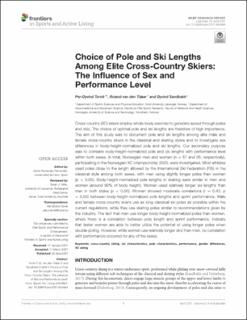| dc.contributor.author | Torvik, Per Øyvind | |
| dc.contributor.author | van den Tillaar, Roland Johannes Wilhelmus | |
| dc.contributor.author | Sandbakk, Øyvind | |
| dc.date.accessioned | 2021-07-27T08:33:59Z | |
| dc.date.available | 2021-07-27T08:33:59Z | |
| dc.date.created | 2021-07-26T14:47:02Z | |
| dc.date.issued | 2021 | |
| dc.identifier.citation | Frontiers in Sports and Active Living. 2021, 3, . | en_US |
| dc.identifier.issn | 2624-9367 | |
| dc.identifier.uri | https://hdl.handle.net/11250/2765324 | |
| dc.description.abstract | Cross-country (XC) skiers employ whole-body exercise to generate speed through poles and skis. The choice of optimal pole and ski lengths are therefore of high importance. The aim of this study was to document pole and ski lengths among elite male and female cross-country skiers in the classical and skating styles and to investigate sex differences in body-height-normalized pole and ski lengths. Our secondary purpose was to correlate body-height-normalized pole and ski lengths with performance level within both sexes. In total, Norwegian men and women (n = 87 and 36, respectively), participating in the Norwegian XC championship 2020, were investigated. Most athletes used poles close to the length allowed by the International Ski Federation (FIS) in the classical style among both sexes, with men using slightly longer poles than women (p < 0.05). Body-height-normalized pole lengths in skating were similar in men and women (around 90% of body height). Women used relatively longer ski lengths than men in both styles (p < 0.05). Women showed moderate correlations (r = 0.43, p < 0.05) between body-height-normalized pole lengths and sprint performance. Male and female cross-country skiers use as long classical ski poles as possible within the current regulations, while they use skating poles similar to recommendations given by the industry. The fact that men use longer body-height-normalized poles than women, where there is a correlation between pole length and sprint performance, indicate that faster women are able to better utilize the potential of using longer poles when double-poling. However, while women use relatively longer skis than men, no correlation with performance occurred for any of the sexes. | en_US |
| dc.language.iso | eng | en_US |
| dc.publisher | Frontiers Media | en_US |
| dc.rights | Navngivelse 4.0 Internasjonal | * |
| dc.rights.uri | http://creativecommons.org/licenses/by/4.0/deed.no | * |
| dc.title | Associations between body-height-normalized pole and ski lengths and performance among male and female elite cross-country skiers | en_US |
| dc.type | Peer reviewed | en_US |
| dc.type | Journal article | en_US |
| dc.description.version | publishedVersion | en_US |
| dc.source.volume | 3 | en_US |
| dc.source.journal | Frontiers in Sports and Active Living | en_US |
| dc.identifier.doi | 10.3389/fspor.2021.654864 | |
| dc.identifier.cristin | 1922687 | |
| dc.description.localcode | Copyright © 2021 Torvik, van den Tillaar and Sandbakk. This is an open-access article distributed under the terms of the Creative Commons Attribution License (CC BY). The use, distribution or reproduction in other forums is permitted, provided the original author(s) and the copyright owner(s) are credited and that the original publication in this journal is cited, in accordance with accepted academic practice. No use, distribution or reproduction is permitted which does not comply with these terms. | en_US |
| dc.source.articlenumber | 654864. | en_US |
| cristin.ispublished | true | |
| cristin.fulltext | original | |
| cristin.qualitycode | 1 | |

